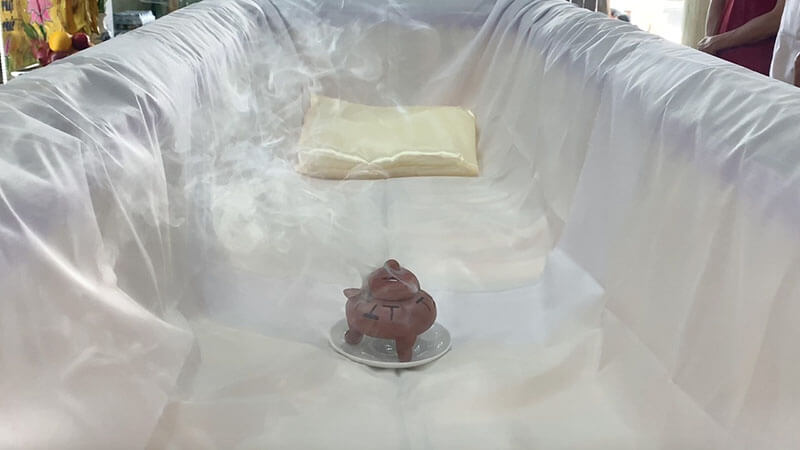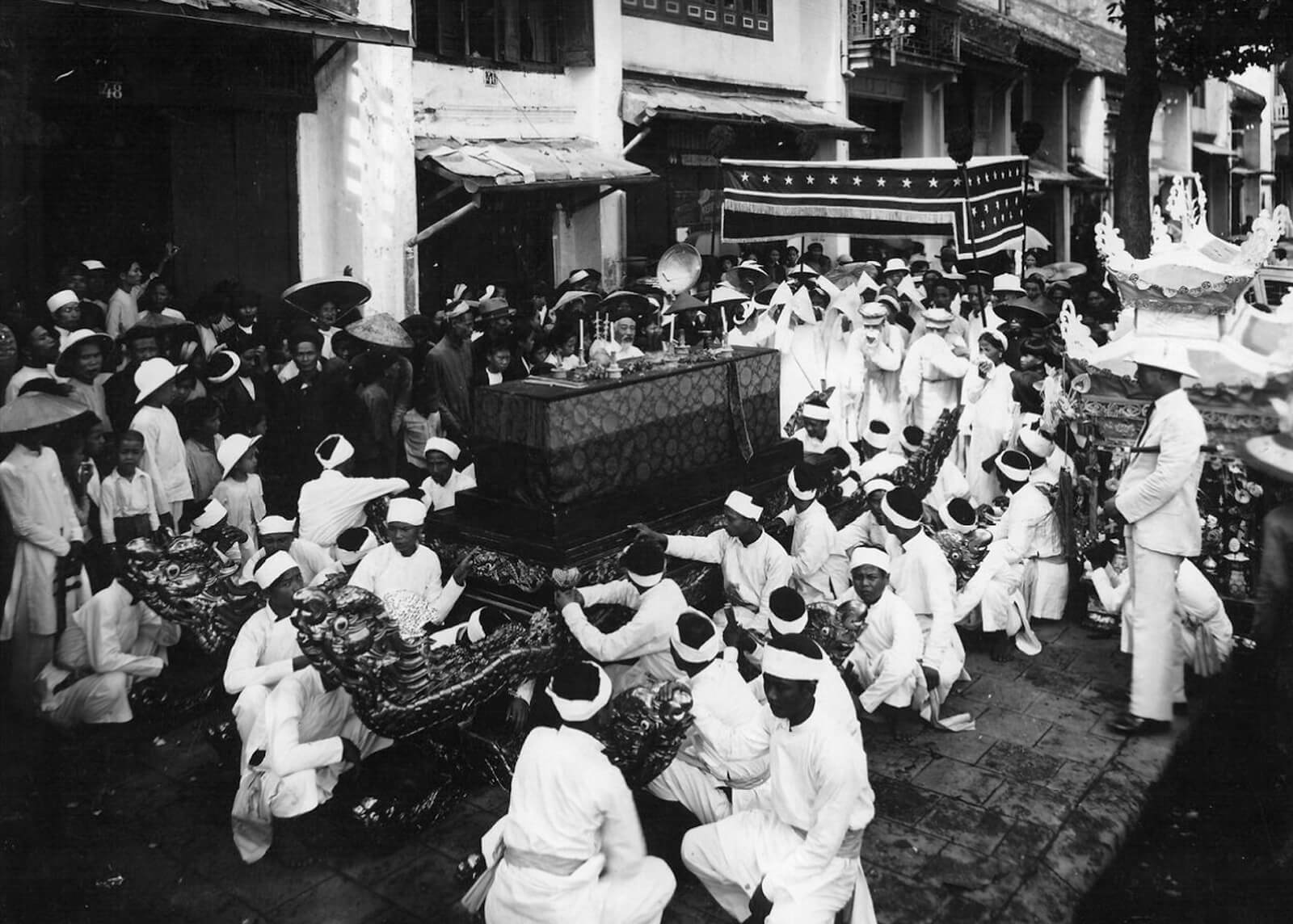Many Vietnamese people believe that “Death is not the end but is the final stage of one life to be transformed into another, so this conception is strongly showed in organizing the funeral procession with various rites and activities.
When a person passes away, the surviving family holds a wake or vigil that typically lasts about three to five days, but may last longer if the surviving family is waiting for other traveling relatives to see the deceased’s face last time.
Most funerals in Vietnam consist of following stages.
Before funeral procession:
The death body is cleaned with alcohol or water (lễ mộc dục), removed from the old clothes and worn in the death clothes (lễ khâm niệm).
A chopstick is laid between the teeth and a pinch of rice and three coins are placed in the mouth (lễ ngậm hàm). Money, gold and rice are placed in the mouth of the dead to indicate that the deceased has left this world without want or hunger. ).
The body is put on a grass mat laid on the ground according to the saying, “being born from the earth, one must return back to the earth”. The corpse is placed inside the coffin (le nhập quan). An altar is set up in the room as a small memorial with a picture of the deceased along with flowers and burning incense.

The deceased’s cloth and family: The clothes are made from white fabric, and not only the death body but also the husband/wife, the son and daughter and the grand sons have to wear this funeral clothes.
An altar is set up in the room as a small memorial with a picture of the deceased along with flowers and burning incense.
The family members then gather before the altar and make offerings of food for the dead person’s soul. This usually is three bowls of rice, three cups of tea, and a few other special dishes. In North Vietnam, it may be different–one bowl of rice, one cup of water, a boiled egg, and a bundle of joss sticks planted in a bowl of uncooked rice and surrounded by lightened candles. This ceremony is supposed to be repeated three times a day during the entire mourning period.
Finally, the funeral ceremony (lễ thành phục) is officially performed. The relatives begin the rite under the leadership of a shaman. All families and relatives will then go slowly around the coffin, in line, to pay respect and to see their deceased family member for the last time. In addition, there is a bowl of rice and an egg place on top of the coffin if the family is Buddhist or non-religion, and a card of the death’s Christian name if he or she is Christian.
In the funeral procession: The date and time for the funeral procession (lễ an tang), must be carefully selected. Relatives, friends, and descendants take part in the funeral procession come to share the sorrow with the family and to accompany the dead along the way to the burial ground.
The coffin is placed at home or at the funeral houses based on the desire of the dead’s family. Distant relatives, neighborhood, friends or colleagues of the death can come to the place, pray for the salvation of the death’s soul, go around the coffin to see the death again and console the death’s family. This stage might take anywhere from a few hours to a whole day, depending on the number of the visitors. Visitors who attend a funeral usually wear dark color clothes and bring sympathy flower, sometimes attached with an envelope containing money to help the unfortunate family cover the cost of the funeral.
When the visiting stage ends, the representative of the family will have a short speech to thank all the visitors and invite them to go with the family to take the death to the cemetery. Votives are dropped along the way. The coffin of the death is moved to a special funeral car and taken to the interring place, followed by the family members and some of the visitors. At the grave site, the coffin is lowered and buried.
In some rural parts of Vietnam, especially with peasants’ families, the coffin is placed in the middle of the rice field and the dead’s eldest son has to walk backward, or even rolling on the muddy ground, to show his regret of his parent’s death.
When the coffin is buried the eldest son, the monk, or funeral attendants throw a symbolic handful of dirt into the grave and then pass on their respects to the rest of the family. Relatives leave the grave but wait a short distance away until the grave is completely covered before they go home.
In the north, a trio of musicians is hired to play traditional funeral music for two days

After the funeral procession
Lễ mở cửa mả: After three days of mourning, the family visits the tomb again; open the grave.
Lễ chung thất: After 49 days the family stops bringing rice for the dead to the altar.
And finally, Lễ tốt khốc: after 100 days the family celebrates the ending of the tears. After one year is the ceremony of the first anniversary of the relative’s death and after two years is the ceremony of the end of mourning.
There are two mains type of interring in Vietnam: burying and burning. The mourning time after the funeral is different based on the position of the death in the family, but mostly from 3 months to 3 years. During the mourning time, the family members have to wear a small black piece of cloth on the arm or chest.
Regular ceremonies are held for the dead person:
Incense is burned for three days after the funeral, flowers are brought and prayers are spoken for the deceased.
– Lễ tạ mộ (visiting the tomb)
The family visits the tomb again after three days of mourning, This ceremony is also held especially on the death anniversary, the lunar New Year Period (Tet) and often on the 1st and 15th days of each lunar month.
–Lễ chung tất after 49 days,
The family members have gathered before the altar and made offerings of food for the dead person’s soul during the entire mourning period so far. But after the celebration of Lễ chung tất, they stops bringing rice to the altar for the dead
– –Lê “tot khoc”, or the end of the tears after 100 days
After 100 days, the family celebrates tot khoc, or the end of the tears.
– Lễ Giỗ (anniversary of the relative’s death after one year)
Once per week, over a period of 49 days, a memorial service is given to further help the family grieve and remember the deceased. A second memorial service is then held 100 days after the death, then another memorial service is held one full year after the death. Families normally have a special dinner on the 49th and 100th day after the death and also on the first anniversary. They may have a dinner every year after that on the death anniversary.
– Lễ đoạn tang ( the end of mourning) after three years.
– Lễ bốc mộ (the body is exhumed) generally after three years or later :
The bones are cleaned and re-arranged in proper order in a small earthenware coffin, or box for final burial. Only relatives and close friends are in attendance, and no special social gathering is held. In the north, the remains are then exhumed and reburied in a small shrine as their final resting place. Both in the north and south, the position of the grave is determined by geomancy.
Mourning Clothing and Prohibitions
-Mourning Clothing
During the period of mourning, descendants wear special mourning clothing. These garments are made of crepe of ample cut with a seam in the middle of the back. All are required to cover their heads Family members are not allowed to wear brightly colored clothing. A black band is worn on the arm by men in mourning and a small black piece of material is worn on the dress of women mourners after the funeral for the entire mourning period if they go to work in the government offices. During subsequent memorial services for the deceased, family members may wear black or white fabric signifying that they are in mourning. The grieving period for immediate family is generally three years.
-Prohibitions
They were not permitted to comb their hair nor have a haircut, nor eat good food. While in mourning, Vietnamese do not usually visit temples and pagodas, festivals, parties, and other entertainments. The mourning period is three years for wives, children, daughter-in-laws, and adopted children of the deceased man and only one year for husbands, son-in-laws, brothers, sisters, nephews, nieces, and grandchildren of the deceased woman. The mourning period is nine months for cousins on the father’s side, and five months by cousins on the mother’s side.
Depending on the relationship to the deceased and how close they were, a family member may not marry or make any other major life decisions for three years following the death of the loved one. They normally delay marriages. Custom dictates that the wedding must be postponed until the end of the mourning period. A mandarin had to resign his position and retire to his home. Conduct memorial ceremonies.
Attention
-If there is a wedding planned in the family, it should be quietly attended to before the ceremony of handing out the mourning clothes.
–Nowadays, mourning ceremonies follow new rituals which are simplified; they consist of covering and putting the dead body into the coffin, the funeral procession, the burial of the coffin into the grave, and the visits to the tomb. The deceased person’s family members wear a white turban or a black mourning band. The foregoing ceremony relates only to the Vietnamese ‘Kinh’ majority. Minority ethnic groups have many different practices, sometimes extremely complex
